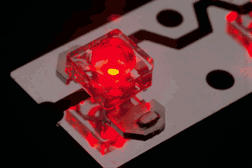FOR IMMEDIATE RELEASE
April 16, 2002
Light-emitting diodes — How they work.
|

THIS IS a photo of a high-brightness LED manufactured by Lumileds Lighting and designed for use in automotive applications (signaling). (Photo provided by Lumileds Lighting.)
Download 300dpi JPEG image, ‘LEDpic5.jpg’, 340K (Media are welcome to download/publish this image with related news stories.)
|
ALBUQUERQUE, N.M. — A photon can be generated in a solid when an electron and hole recombine. Light-emitting diodes (LEDs) take advantage of this radiative recombination process to produce photons by providing a structure that injects electrons and holes (an absence of an electron that electrically behaves like a positive charge). The most common structure for an LED uses a semiconductor diode with a junction between an n-type (conduction via electrons) and a p-type (conduction via holes) region. When the device is forward biased, electrons from the n-type region and holes from the p-type region meet at the junction and recombine radiatively emitting photons.
Most LEDs presently use compound semiconductors. The color of the light is determined by the bandgap of the semiconductor. LEDs using AlInGaP compound semiconductor alloys can emit in the yellow-red spectrum, while LEDs using AlInGaN compound semiconductor alloys can emit in the UV-blue-green spectrum. A combination of red, green, and blue LEDs, or a blue or UV LED with phosphors, can be used to create white light.
LEDs can also be made using organic emissive materials. The fundamental process is the same — radiative relaxation of an excited state. Electrodes are used to selectively excite levels in an organic molecule. Organic LEDs are also under development for displays and for solid-state lighting.
Sandia is a multiprogram laboratory operated by Sandia Corporation, a Lockheed Martin Company, for the United States Department of Energy under contract DE-AC04-94AL85000. With main facilities in Albuquerque, N.M., and Livermore, Calif., Sandia has major research and development responsibilities in national security, energy and environmental technologies, and economic competitiveness.
Sandia Media Contact: Chris Burroughs, coburro@sandia.gov, (505) 844-0948
Sandia Technical Contact: Bob Biefeld, rmbiefe@sandia.gov , (505) 844-1556
|
